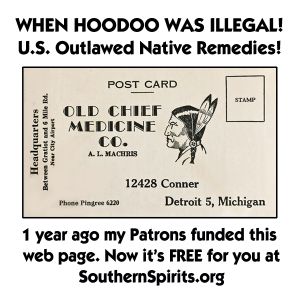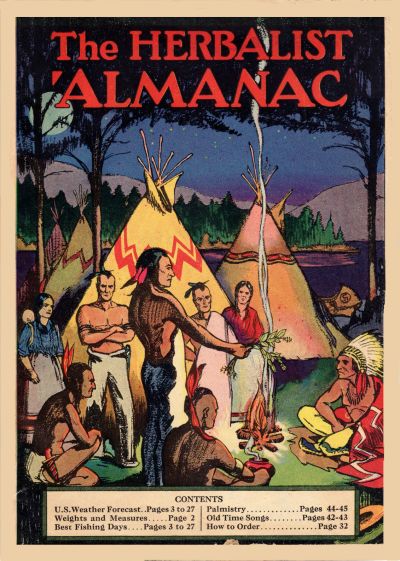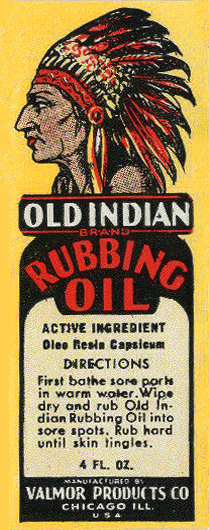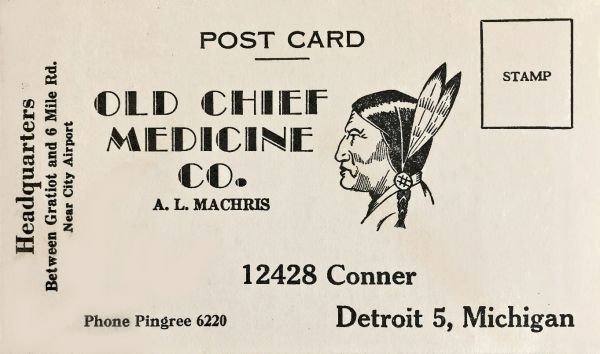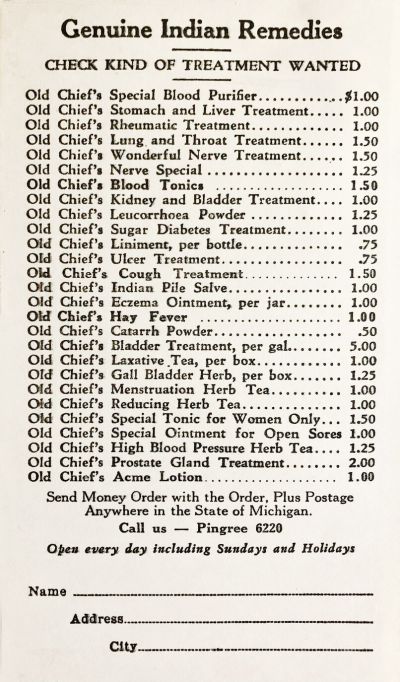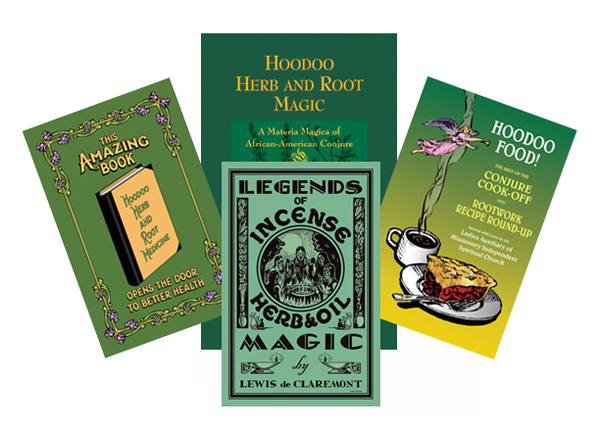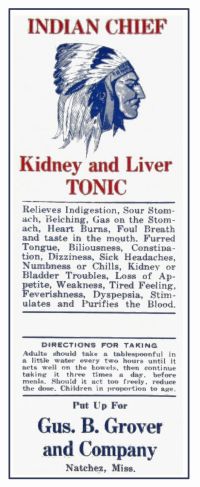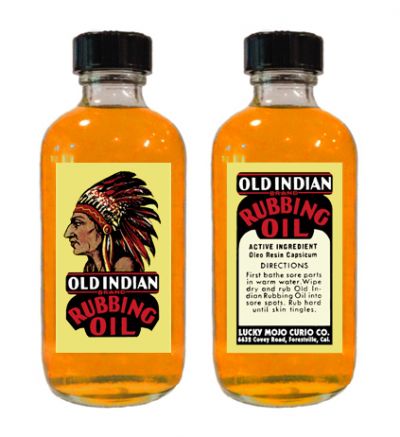When Hoodoo Was Illegal: Alphonse L. Machris and the Old Chief Medicine Co., 1950-1952
For a small monthly donation, my Patrons gain exclusive early access to this page in its entirety, with high-res graphics and full commentary. Patreon subscribers also have access to my Private Patreon Forum, where we can discuss my research projects on the topics of divination, folklore, and magic. After one year, this page will go public.
* Patreon Date: November 14th, 2021.
* Public Date: November 14th, 2022.
Please consider subscribing to my Patreon stream for as little as $2.00 per week:
Patrons: To discuss this and other Patreon projects with me, please join my private Patreon Forum:
Support Southern Spirits
In this installment of "Where the Southern Cross the Yellow Dog" i offer you a private upcoming page that will eventually be on display at the Southern Spirits web site. As a Patreon supporter, you have access to the page one full year before the public does.
This new page offers a brief but shocking look at the lengths that the United States government went to, during the 20th century, in its campaign to suppress American folk magic and herbal medicine.
It's All Ephemera with Cat Yronwode
The finished pages of "When Hoodoo Was Illegal" will be released live to the public in 2022. To discuss this page and other Southern Spirits Patreon pages with me, join my private Patreon Forum here:
Private Patreon Forum for "Where the Southern Cross the Yellow Dog
WHEN HOODOO WAS ILLEGAL:
The United States of America versus the Old Chief Medicine Co., 1950-1952
In documenting the history of hoodoo it is important to range afield from the topic of folk magic and into the topic of folk medicine for the simple reason that until the mass-urbanization of black Americans, most rural rootworkers were also root doctors who served as medical prescriptionists. Likewise, many travelling psychic readers, both black and white, worked as pitchmen in medicine shows or sold herbal formulas in outdoor markets or at carnivals.
Two important tropes in the branding and marketing of herbal remedies were that they used Native American plants and were old American "Indian" recipes, or that they were "Old Country" remedies from Europe, or sometimes from Africa, and had nostalgic or ancestral family value.
In this case i'd like to examine how the Food and Drug Administration succeeded in condemning and destroying several shipments of herbal remedies from 1950 through 1952.
Joseph E. Meyer and Indiana Botanic Gardens
I have written elsewhere about Joseph E. Meyer and his famed family enterprise, the Indiana Botanic Gardens. Meyer had passed away in 1951, so at the time of this event, he and his son Clarence Meyer, the talented artist and writer who produced the company's catalogues, pamphlets, and books, were jointly running the company in charge. Like many compounders of herbal formulas for health and healing, Meyer used the image of Native American medicine men on his company catalogues.
Morton G. Neumann and Valmor Products
In writing about the role that Meyer played in hoodoo and herbal medicine, i have mentioned that Indiana Botanic Gardens was a bulk supplier of herbs for a number of other medical and magical mail order companies, including Morton Neumann's King Novelty / Valmor / Famous Products brands in Chicago and the Shapiro family's Lucky Heart brand in Memphis. Neumann had his own line of Native American medicines, which included Old Indian Rubbing Oil.
Meyer also supplied and private labelled the herbs sold by the Illinois Herb Company / Healthways in Chicago, and Healthways further marketed hoodoo and occult classic books, such as the works of Henri Gamache (Anne Fleitmann) and Mikhail Strabo (Sydney J. R. Steiner) which they either bought from Neumann in Chicago or directly from the printers in New York. In fact, until the late 1990s, when Indiana Botanic Gardens ended their distribution of bulk herbs in favour of handling only capsulized herb powders, the company, still family-owned, was a major supplier to my own Lucky Mojo Curio Co., in Forestville, California.
Alphonse L. Machris and the Old Chief Medicine Co.
As a result of the Food and Drug Administration's actions, we are able to learn that the Meyer family also manufactured bulk herbal drug formulas for private labelling by the Old Chief Medicine Co. of Detroit, Michigan.
What little i know about the Old Chief Medicine Co. comes from this lawsuit and from an advertising postcard in my collection which was printed by the company for customers to use as a return-mail order form, perhaps accompanying a catalogue. The date of the postcard is unknown but the lettering and type style, as well as the old telephone exchange and lack of a postal zip code, would place it as early as the 1920s and as late as the 1940s.
The back of the card contains a complete list of herbal remedies, all of which were evidently compounded by the Indiana Botanic Gardens. There is an oddity about the card, however. The customer is requested to accompany the completed order form with a money order or cash -- and this could not be accomplished if the card was mailed as a self-addressed postcard to the company.
In any case, from this card we learn that the proprietor of Old Chief Medicine Co. was A. L. Machris, and the address was 12428 Conner Street, Detroit, Michigan, with a phone number of Pingree 6220. The address is now a small grass-covered vacant lot, and it was vacant as early as 2008, when it was first captured by Google Street View. As the card notes, it is across Conner Street from the Detroit City Airport (now Coleman A. Young International Airport), which opened in 1927. In fact, directly across Connor from the lot stands a magnificent 1929 art deco airplane hangar designed by the famed Detroit architect Albert Kahn, which was completed in 1929.
The owner of the company at the time the postcard was issued was A. L. Machris, and from the "Detroit Free Press" newspaper of December 30, 1946, we learn the following:
MRS. ROSE J. MACHRIS: Services for Mrs. Machris will be held at 1 p. m. Tuesday from the Verheyden Funeral Home, 16300 Mack. Mrs. Machris, 64, who died Saturday, had been a resident of Detroit for 52 years. Survivors include her husband Alphonse L. Machris; three daughters, Mrs. Russell Burns, Mrs. Glenn Barr [Lorraine Clementine Machris Barr Lemoine], and Mrs. Barron Wyatt; one sister, two brothers, and three grandchildren. Dr. Calvin F. Stickles of the Reformation United Lutheran Church will officiate at the services. Burial will be at White Chapel Cemetery.
Rose J. Machris died at the age of 64 in 1946, so she was born in 1882. If Alphonse L. Machris was about the same age or the customary year or two older than his wife, then, according to Ancestry.com. he is this man:
Alphonse Machris (1881 - 1942 [wrong]). Born in Alsace Lorraine, France on 31 Aug 1881 to Francois Leon Machris and Marie Victorine Klein. Alphonse Machris married Clementia Catharina Heim (1878 - 1919) and they had 3 children: Leon Machris (1906 - 1930), Marion Machris (1912 - Unknown), and Lorraine Clementine Machris (1915 - 2004). He also married Rose Britton (1882 - Unknown [actually 1946])
Now, obviously, if Rose's husband Alphonse survived her death in 1946, he cannot have died in 1942, as per the above record at Ancestry, but on the very same Ancestry web page it is also noted that Alphonse passed away "after 1942 in Detroit, Wayne County, Michigan." How long "after 1942" he lived we do not know, but he was alive in 1946 when Rose died, and unless someone succeeded him as the proprietor of the Old Chief Medicine Co., he was alive after 1951, when the FDA made its last of five confiscations at his business.
After Clementia's death in 1919, Alphonse married Rose Britton. Rose seems to have adopted Lorraine, Leon, and Marion, and the couple produced at least one more daughter, as evidenced in Rose's obituary: Leon, the son, died before Rose; Lorraine survived Rose and was listed as her daughter in the obituary, although they were not biologically related; however, because Marion's death date is as yet unknown, she may be one of the two daughters listed in Rose's obituary as Mrs. Russell Burns or Mrs. Barron Wyatt ... which leaves us in search of at least one other daughter.
None of this side-tripping into genealogy helps us understand the Old Chief Medicine Co. any better. All we know is that Alphonse L. Machris was a German-American immigrant, his middle name was probably Leon, after his father; he was 40 or 50 years of age when he began selling herbal remedies by mail in the 1920s or 1930s; he married twice and had several children; he survived his second wife's death while in his 60s; the family attended the Reformation United Lutheran Church; and the Food and Drug Administration first cracked down on his business in 1950, when he was 68 years old.
Oh, and one more thing: Despite facing the airport, the Machris lot is on a verdant, tree-rich street lined with semi-rural single-family houses, and cannot have been a factory, warehouse, or storefront. Thus we know that the Old Chief Medicine Company was a home business. It is located in the upper east side neighbourhood of LaSalle College Park, where at the present time 92% of the residents are African American.
FDA Seizes and Destroys Herbal Remedies, 1950-1952
From 1950 through 1952, the Food and Drug Administration of the United States confiscated goods and brought actions against Indiana Botanic Gardens and the Old Chief Medicine Company. Their description of this action was outlined in the cryptic official title "Indiana Botanic Gardens Old Chief Seized Formulas 1952."
The case itself, presented in the form of legal documentation, is a bit dry, so i have taken the liberty of rearranging the paragraphs in order to more clearly bring out the embedded text that contains the actual formulas used by Indiana Botanic Gardens and the Old Chief Medicine Co. I do this because people often ask me, "Where do you get your recipes?" and this, my friends, is one way.
These herb mixtures are accurately described with respect to their traditional prescriptive qualities. They are in no way fraudulent. It was the United States government, acting on behalf of the chemical-pharmaceutical companies, that virtually outlawed botanical medicine from the 1910s until the 1960s era of the hippies. (Yes, you can thank the hippies for your modern herbal supplements, but that's another story for another day.)
Because these herb mixtures can easily form the basis for magical work as well as medical prescriptions, i have added notes about their use in hoodoo, in the form of mojo hands to support health and healing, as incenses to burn on charcoal while praying, or as tea-baths for personal use. To provide a substantive background for the addition of mojo hands and bath-teas to this page, i offer as reference four books i have written, co-written, compiled, edited, and published on the entwined topics of herbal medicine, herb magic, herbal folklore, and magical cookery with herbs. They are "Hoodoo Herb and Root Magic: A Materia Magica of African-American Conjure," "This Amazing Book: Hoodoo Herb and Root Medicine Opens the Door to Better Health," "Hoodoo Food! The Best of the Conjure Cook-Off," and "Legends of Incense, Herb, and Oil Magic."
$38.00
BOO-SPE-BOTA: Botanical Book Bonanza
CLICK HERE TO BUY THIS FOUR-BOOK COLLECTION FROM LUCKY MOJO!
So here we go, and, to make everything clear, in what follows, my comments are in italics.
Indiana Botanic Gardens Old Chief Seized Formulas 1952
3784. Misbranding of herb preparations. U. S. v. 29 Bottles, etc.
You gotta love that. The entire weight of the United States versus "29 bottles, etc." The mind boggles.
FILED: On or about April 29, 1952, Eastern District of Michigan.
ALLEGED SHIPMENT: On or about November 24, 1950, and February 26, April 24, May 25, and June 13, 1951, by the Indiana Botanic Gardens, from Hammond, Ind. [and confiscated] at Detroit, Mich., in possession of the Old Chief Medicine Co.
Old Chief's Prostate Treatment
29 bottles of Old Chief's Prostate Treatment,
- Active Ingredients: An Infusion of Palmetto Berries, Damiana, Juniper Berries, Bearberry Leaves, Corn Silk, and Althea. Contents: 16 fl. ounces"
Misbranding:
- "This preparation [is] used for Prostate weakness."
- "Increases the functional activity [of the prostate or the uro-genital system in men]."
Use in Magic: Palmetto Berries are also sold as Saw Palmetto Berries. Damiana, Juniper Berries, and Bearberry Leaves (also known as Kinnikinnick) are common articles in the hoodoo shops. Corn Silk is not an article of popular commerce. To properly gather it, you would want the stigmas or silk from a female Corn plant flower before the cob develops, but anyone can buy Corn on the cob, peel off the remnant tassels or silk, and dry then with gentle heat. Althaea Leaf and Althaea Root are common articles in conjure practice as well as in herbal medicine. So our herbal bath-tea or mojo hand for male uro-genital support could contain the following: Saw Palmetto Berries, Damiana, Juniper Berries, Bearberry (Kinnikinnick) Leaves, dried Corn Silk, and Althea Leaf or Althaea Root.
Old Chief's Nerve Special
13 bottles of Old Chief's Nerve Special
- Active Ingredients: Valerian Root, Lady Slipper, Black Cohosh, Skunk Cabbage, Catnip, Hops, and Haw, Alcohol 10 percent.
Misbranding:
- "It has restored health, to thousands."
- "The Way To Health."
- "Effectiveness in giving relief and in remedying ailments."
- "They [the herbs] are of great benefit in the ailments for which they are recommended."
- "They [the herbs] are reliable."
Use in Magic: Valerian Root is called Vandal Root in hoodoo practice. Lady Slipper, a genus of wild Orchids, will be almost impossible to find in commerce, as they are illegal to pick or dig up on Federal properties and are decreasing in population due to over-harvesting and habitat destruction. Black Cohosh is known in hoodoo as Black Snake Root. Skunk Cabbage (Symplocarpus foetidus), a mild sedative, is available in the form of dried roots, cut and sifted, through herb medicine shops but there is no particular call for it in conjure. Catnip and Hops Flowers are common articles in the conjure community. So our herbal bath-tea or mojo hand for nervous disorders could contain the following: Vandal Root, Black Snake Root, Skunk Cabbage (optional), Catnip, and Hops.
Old Chief's Indian Gall Bladder Herb Tea
26 cartons of Old Chief's Indian Gall Bladder Herb Tea
- Active Ingredients: Wallwort, Flaxseed, Boneset, Buckthorn, and Marshmallow. Contents: 8 Oz. Adv.
Misbranding:
- "It has restored health, to thousands."
- "The Way To Health."
- "Effectiveness in giving relief and in remedying ailments."
- "They [the herbs] are of great benefit in the ailments for which they are recommended."
- "They [the herbs] are reliable."
Use in Magic: Wallwort is a common name given to several plants, but most of the time it applies to Dwarf Elder (Sambucus Ebulus), also known as Danewort. The Elder genus is widespread in Europe, Asia, and North America, do, lacking access to that specific species of Elder, i would make do with any species of Elder Flowers or dried Elderberries. Flax Seed and Boneset (also called White Snake Root) are easy-to-find articles of commerce in the herb trade, and any hoodoo shop should stock them. The common name Buckthorn may refer to a European species (Ramnus cathartica) which has become naturalized and invasive in the United States, but the herbal mix was more than likely was made with a North American species such as Alder-Leaf Buckthorn (R. alnifolia); Carolina Buckthorn (R. caroliniana); Cascara Buckthorn (R. purshiana),; California Buckthorn, also known as Coffeeberry (R. californica); or Hollyleaf Buckthorn (R. crocea). As the species and common names "cathartica" and "Cascara Buckthorn" indicate, this is a cathartic medicine. one that produces an emptying, cleansing, purging, or evacuation of the bowels. Marshmallow (Malva sp.) is found in commerce, but more common in hoodoo is the related Althaea Leaf or Root (Althaea sp.). They are used quite interchangeably in both rural herb medicine and folklore. So our herbal bath-tea or mojo hand for gall bladder disorders could contain the following: Elder Flowers of Berries, Flax Seed, Boneset (White Snake Root), Buckthorn, and Marshmallow or Althaea Leaf or Root.
Old Chief's Indian High Blood Pressure Herb Tea
10 cartons of Old Chief's Indian High Blood Pressure Herb Tea
- Active Ingredients: Mistletoe, Marshmallow, Sassafras, and Licorice. Contents: 8 Oz. Adv.
Misbranding:
- "It has restored health, to thousands."
- "The Way To Health."
- "Effectiveness in giving relief and in remedying ailments."
- "They [the herbs] are of great benefit in the ailments for which they are recommended."
- "They [the herbs] are reliable."
Use in Magic: Mistletoe, Marshmallow (or its common substitutes, Althaea Leaf or Althaea Root), Sassafras Root Bark, and Licorice Root are all popular articles in commerce in the hoodoo and folk magic community. So our herbal bath-tea or mojo hand for lowering blood pressure and supporting other circulatory disorders could contain the following: Mistletoe, Marshmallow (or its common substitutes, Althaea Leaf or Althaea Root), Sassafras Root Bark, and Licorice Root.
Old Chief's Indian Reducing Obesity Herbs
6 cartons of Old Chief's Indian reducing obesity Herbs
- Active Ingredients: Sassafras, Elder Flowers, Rosemary, Chickweed, Horsetail Grass, Poke Root, Yerba Santa, Juniper, and Licorice.
Misbranding:
- "It has proven valuable to thousands."
- "This is a saline."
- "Very effective in correcting overweight."
- "The Way to Health."
Use in Magic: Sassafras, Elder Flowers and Rosemary are common articles of commerce at hoodoo drugstores and candle shops. Chickweed (Stellaria media) is popular in herbal medicine and, used fresh, as an addition to salads; it can readily be found in dried form in herb stores. Horsetail Grass (Equisetum spp.), also known as Souring Rush, is found in Asia, Europe, North Africa, and North America; not commonly mentioned in hoodoo recipes, it is a staple article of commerce in herbal medicine stores. Poke Root (Phytolacca americana) is likewise more often found in medical herb stores than in conjure shops, but is readily sourced and easy to purchase. Yerba Santa, Juniper Berries, and Licorice Root are common ingredients in hoodoo and conjure formulas. So our herbal bath-tea or mojo hand for supporting weight loss could contain the following: Sassafras, Elder Flowers, Rosemary, Chickweed, Horsetail Grass, Poke Root, Yerba Santa, Juniper, and Licorice.
Old Chief's Indian Laxative Herb Tea
10 packages of Old Chief's Indian laxative herb tea
- Active Ingredients: Buckthorn, Licorice, Senna Sagrada, Senna Tinnevilly, and Cascara Alexandria. Contents: 7 Oz., Adv."
Misbranding:
- "The herbs used in this combination have no habit forming effects."
- "It has restored health to thousands."
- "Used for chronic constipation of long standing conditions."
- "The Way To Health."
- "Effectiveness in giving relief and in remedying ailments."
Use in Magic: See above for more on Buckthorn. Licorice Root is a common item in commerce in conjure shops. "Senna Sagrada" is probably a typographical conflation of Senna (Senna spp.) and Cascara Sagraga (Frangula purshiana). Senna Tinnevilly, also spelled Senna Tinnevelly in old herb catalogues, is simply Senna from Tinnevelly, a city now known as Tirunelveli, Tamil Nadu, India; any source should be acceptable, of course. Senna is available in both herb shops and conjure shops in the form of Senna Leaf (a mild-laxative) or Senna Pods (a moderately strong laxative). Cascara Alexandria could be Cascara Sagrada from Alexandria, Egypt, but it is much more likely to be the dried fruit of the Coffee tree, commonly called Cascara Coffee, Coffee Cherries, or Coffee Cherry Tea. Often treated as a mere byproduct that is discarded during the production of Coffee Beans, the fleshy outer layer that covers the bean, called Cascara (Arabic for "rind," "peel," "husk," or "bark"), contains a modest amount of caffeine and is a mild laxative, similar to, but weaker than, Coffee Beans. When brewed it has a flavour resembling Cherry or Hibiscus tea. Cascara Coffee Cherry Tea can be found in some health food stores; you could substitute Coffee Beans if so inclined. So our herbal bath-tea or mojo hand for supporting colon health and bowel regularity could contain the following: Buckthorn, Licorice, Cascara Sagrada, Senna Leaf or Pods, and Cascara Coffee Cherry Tea or Coffee Beans.
RESULTS OF INVESTIGATION:
The products were shipped in bulk and were repackaged and relabeled by the consignee.
NATURE OF CHARGE:
Misbranding, Section 502 (a), the statements on. the labels of the articles were false and misleading since the articles were not effective for the purposes and conditions stated and implied and since frequent or continued use of Old Chief's Indian Laxative Herb Tea was capable of establishing dependence upon laxatives to move the bowels:
Further misbranding, Section 502 (f) (2), the labeling of the Old Chief's Indian laxative herb tea failed to bear adequate warnings against use in those pathological conditions where its use may be dangerous to health, or against unsafe duration of administration, in such manner and form, as are necessary for the protection of users, since it failed to bear a warning to the effect that the article should not be taken in case of acute abdominal pains, nausea, vomiting, or other symptoms of appendicitis, and that frequent or continued use of the article may result in dependence upon laxatives to move the bowels. The articles were misbranded in the above respects while held for sale after shipment in interstate commerce.
Further misbranding, Section 502 (f) (1), the labeling of the articles other than the Old Chief's Indian Laxative Herb Tea failed to bear adequate directions for use since it failed to state the purposes for which the articles were to be taken. These articles were misbranded in this respect when introduced into and while in interstate commerce.
DISPOSITION:
June 5, 1952. Default decree of condemnation and destruction.
DRUGS ACTIONABLE BECAUSE OF DEVIATION FROM OFFICIAL OR OWN STANDARDS
And there we have it. Now, aren't you glad that the FDA noted all those ingredients? That is a beginning to your own herbal medicine chest and a fine addition to your magical herb journal.
Other Indian Herbs and Tonics
From the late 19th century onward, makers of herbal formulas fought an uphill battle against the FDA, the United States Postal Service, and the chemical-pharmacy combines. Making any claims for efficacy was forbidden, and certain combinations of herbs came under special scrutiny or were presented for public ridicule without scientific evaluation. Despite this, herb doctors all around the country kept on blending herb mixtures for use as teas and poultices, alcohol-based tonics or extracts of medical herbs, and oil or turpentine-based liniments and rubbing oils -- all using the image of a Native American medicine man, as a sign of authenticity.
A representative item from my collection is the label for Indian Chief Kidney and Liver Tonic "put up for Gus. B. Grover and Co." of Natchez, Mississippi, circa 1910 - 1930. The technical term "put up for" means that, just as with the Old Chief Medicine Co., some manufactory created the tonic and sold it in bulk to Mr. Grover for private labelling. Unless we find a federal lawsuit against the product we won't know who made it, but there is no doubt that the ingredients would have been similar to the kidney and liver tonics made by Indiana Botanic Gardens.
Catherine Yronwode and the Lucky Mojo Curio Co.
I loved Valmor's Old Indian Rubbing Oil, so after the death of Morton Neumann in the 1980s and the lapse of his trademark, i took on the task of making it. It is a delightfully stinky, skin-warming, counter-irritant oil in the old school tradition.
Lucky for me, the hippies (myself included) fought the law ... and we won.
To Discuss This Patreon Page
This Patreon Bonus Page is part of the series titled "Where the Southern Cross the Yellow Dog." To discuss it with me and the Patreon community, please visit our Private Patreon Forum at
https://forum.luckymojo.com/where-the-southern-cross-the-yellow-dog-t94019.html
Thank you.
catherine yronwode
curator, historian, and docent
Where the Southern Cross the Yellow Dog
Special thanks to my dear husband and creative partner nagasiva yronwode for scans and clean-ups and to Fred Burke for encouraging me to explain how i develop mojo hands and herbal bath-teas for magical use from old medical herb formulas.
